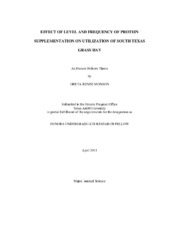| dc.description.abstract | Reducing the frequency of supplementation is an effective means of reducing cost. However, little research has been conducted evaluating the level of supplemental protein required with infrequent supplementation. Therefore, our objective was to quantify forage utilization when grade levels of protein were delivered infrequently. Five ruminally cannulated Angus × Hereford steers (BW = 410 ± 43 kg) were used in a 5 × 4 incomplete Latin square. Steers were provided ad libitum access to native grass hay (2.3 % CP, 81.8% NDF). Treatments were control (0), 160/d, 160/3d, 320/3d, and 480/3d (mg of N/kg BW given daily (/d) versus every third day (/3d)). Supplemental protein was provided as a range cube (40.7% CP) fed at 0645h. Experimental periods were 18 d long. Forage intake was determined from d 10 through 15 to correspond with fecal grab samples collected from d 11 to d 16. Acid detergent insoluble ash was used as an internal marker to estimate fecal production. On d 16 to d 18 of each period ruminal fermentation profiles were performed. Hay OM intake was 4.41, 6.18, 5.46, 6.10, and 6.27 kg/d for 0/d, 160/d, 160/3d, 320/3d, and 480/3d. There was a linear increase (P < 0.01) with increasing level of protein provided every third d, but 160/d did not differ from 160/3d, 320/3d, and 480/3d (P > 0.05). Total OM intake responded in a similar fashion; however, 160/3d was less than 160/d (P < 0.05; 7.08 and 5.83 kg/d, respectively). Total digestible OM intake increased quadratically (P = 0.06) with increasing protein provision every third d (2.02, 2.82, 3.59, and 3.34 kg/d for 0/d, 160/3d, 320/3d, and 480/3d, respectively). When supplement was provided at 160/d total digestible OM intake was 3.30 kg/d, which did not differ from any treatment receiving supplement. There were no significant effects (P > 0.05) on digestibility. Reduced levels of protein supplemented infrequently may be an effective means of capturing additional cost savings. | en |


